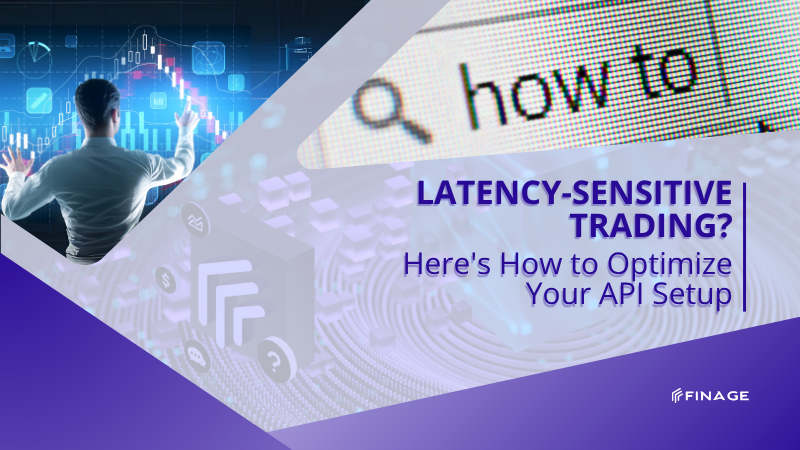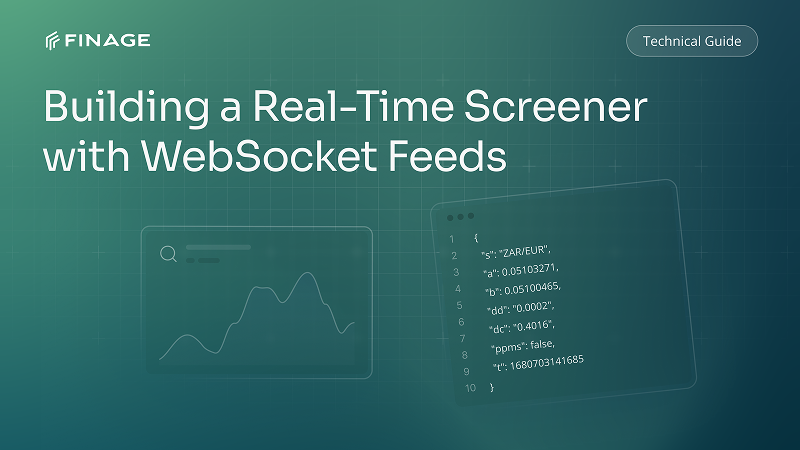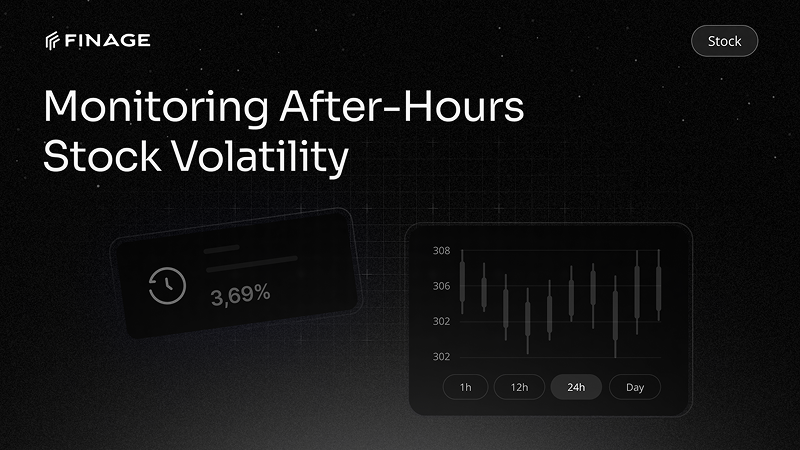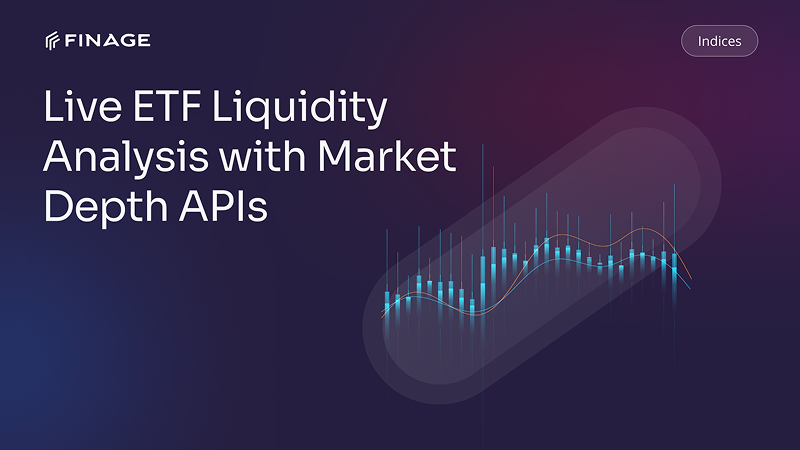Latency-Sensitive Trading? Here's How to Optimize Your API Setup
13 min read • June 23, 2025

Introduction
In the world of trading, milliseconds can make the difference between a profitable position and a missed opportunity. Whether you're building a high-frequency trading strategy or a responsive retail platform, latency—the delay between data request and delivery—can quietly erode performance. And in API-driven architectures, that delay often starts before you even receive your first tick.
For latency-sensitive trading environments, optimizing your API setup isn’t a nice-to-have—it’s mission-critical.
In this guide, we’ll explore the API-level decisions that can speed up your trading infrastructure: from endpoint location and request frequency, to data format, rate limiting, and caching strategies. If you’re using APIs to power trades, analytics, or market reactions, this article will help ensure you’re not leaving speed—and profit—on the table.
Table of Contents
- Understanding Latency in Trading Systems
- Choosing the Right Data Provider and Endpoint Location
- REST vs. WebSocket: When and How to Use Each
- Streamlining Your Request Logic for Speed
- Caching and Preloading Critical Data
- Managing Rate Limits Without Slowing Down
- Normalization, Parsing, and Minimizing Payload Overhead
- Infrastructure Design: Proxies, Queues, and Failover
- Monitoring Latency: What to Measure and Why
- Final Thoughts: Why Finage Enables Faster Market Access
1. Understanding Latency in Trading Systems
Latency in trading isn’t just about speed—it’s about timing and execution under pressure. Every trading system, whether institutional or retail, operates on the assumption that incoming data is both accurate and immediate. When that assumption fails, trades are executed on outdated information, and strategies begin to fall apart.
What is latency?
In the context of trading APIs, latency refers to the delay between a data event occurring (like a price update) and your system reacting to it. It consists of multiple layers:
- Network latency: Time it takes for data to travel from provider to your server
- Processing latency: Time it takes to parse and act on that data in your app
- Execution latency: Time from decision to order placement and confirmation
When dealing with fast markets—like forex, crypto, or volatile equities—even 100ms delays can result in significant pricing differences or missed execution windows.
Why it matters in API-based systems
Many modern trading apps rely on API feeds for both market data and order routing. That means latency doesn’t just impact analytics—it affects real capital. For example:
- A REST request that takes 500ms instead of 50ms may delay the trigger of an entry or exit
- A WebSocket feed with a 2-second lag can cause price discrepancies on the frontend
- A slow response to order status APIs might leave the user in the dark during critical moments
In short, unoptimized API latency results in worse fills, slower signals, and a degraded user experience—especially in fast-moving markets.
2. Choosing the Right Data Provider and Endpoint Location
No matter how fast your app or algorithm is, you can’t beat geography. In latency-sensitive trading environments, even the most efficient code will underperform if it’s fetching data from an endpoint half a world away.
Proximity matters
The physical distance between your servers and your data provider’s endpoints impacts how quickly you receive updates. This is especially true for REST requests and WebSocket handshakes. Even with optimized routing, transcontinental delays can add 100ms or more—enough to affect fill prices or signal timing in live markets.
Where possible:
- Deploy your backend close to your data provider’s infrastructure
- Choose a provider with multiple regional endpoints
- Use a provider like Finage, which offers low-latency access points in key financial regions
API location ≠ market location
One common misconception is that data should come from where the exchange is located. But what really matters is where your trading system resides. If your app runs in London and your data feed is hosted only in the U.S., you’ll introduce avoidable lag—even if you're trading European assets.
Look for providers who offer:
- Edge-delivered APIs: To ensure minimal network distance
- Cloud-region compatibility: To deploy close to AWS, Azure, or Google Cloud zones
- Failover infrastructure: So that if one node slows down, another can take over without added latency
Test before committing
Before finalizing your provider, measure:
- Ping times to the API servers
- Time to first byte on a simple REST call
- WebSocket handshake duration and average update interval
This testing helps you understand real-world latency before your users (or your strategy) feel the impact.
3. REST vs. WebSocket: When and How to Use Each
In trading systems, choosing between REST and WebSocket isn’t just about data delivery—it’s about how your system reacts to markets. The wrong choice can introduce unnecessary latency or overwhelm your infrastructure. The right combination offers both speed and efficiency.
REST: Best for snapshots and precision
REST APIs are well-suited for:
- One-time data pulls (e.g., OHLCV, company fundamentals)
- Historical data access
- Polling low-frequency updates (e.g., once per minute for slower assets)
- Placing and checking orders (in many broker systems)
However, REST is request-response. If you're polling every second to simulate “live” data, you’re adding:
- Unneeded server load
- Network roundtrips
- Potential rate-limit risks
For real-time needs, REST alone is not enough.
WebSocket: Designed for low-latency, real-time data
WebSockets are persistent connections where the server pushes updates as they happen. Ideal for:
- Streaming price updates
- Order book changes (Level 1 or Level 2 data)
- Trade ticks and market depth
- Live economic indicators or alerts
WebSocket latency is typically much lower than REST because there’s no overhead from repeated handshakes or data requests.
Using Finage’s WebSocket APIs, developers can subscribe to specific symbols and receive instantaneous updates with minimal delay—no polling required.
Combine them strategically
The most efficient latency-aware systems use both:
- Use WebSocket for high-frequency data: prices, trades, order books
- Use REST to bootstrap historical data or fill in context before live updates begin
- Use REST for reconnection or snapshot validation after a disconnection
This hybrid model ensures your trading logic always has the most current and most complete picture.
4. Streamlining Your Request Logic for Speed
Even with the fastest endpoints and optimal protocols, poor request patterns can create bottlenecks. Whether you're pulling data for charting, triggering a trade, or refreshing market summaries, how you structure your API logic has a direct impact on latency.
Reduce redundant calls
One of the most common mistakes is repeatedly requesting the same data:
- Re-fetching the same quote every second via REST
- Requesting large historical datasets for every user action
- Polling order status in a tight loop
These practices waste bandwidth, exhaust rate limits, and introduce jitter. Instead:
-Use delta updates where available (e.g., only changes in bid/ask, not full books)
-Store recent values locally or in cache and refresh them only on events
-Debounce user-triggered refreshes to avoid spamming the API
Batch requests when possible
Many APIs—including Finage’s—allow for batching. Instead of sending 10 individual requests, group them into one. This reduces:
- Network overhead
- Queue congestion
- Processing time on both sides
For example: request prices for multiple symbols in a single endpoint call rather than looping through them one by one.
Use parallelism smartly
Modern trading platforms often deal with multiple assets simultaneously. If you must make several requests, make them concurrently—as long as your system can handle it. Async architectures or background workers can ensure your UI or strategy isn’t blocked waiting on serial fetches.
Be mindful of payload size
Big payloads take longer to process and transmit. If you don’t need it, don’t request it:
- Limit history depth on chart requests (e.g., last 100 candles, not 10,000)
- Avoid verbose or unused fields in API responses (some providers allow field filtering)
- Compress or truncate on your own side where possible
Lightweight, targeted requests are always faster—especially under load.
5. Caching and Preloading Critical Data
While real-time accuracy is essential, not every data point needs to be fetched from the source every time. In latency-sensitive systems, smart caching and data preloading can cut response times dramatically—especially during user interaction or market spikes.
Cache static or infrequently changing data
Some information doesn’t change often and can be safely cached:
- Instrument metadata (e.g., symbol names, tick sizes)
- Market hours and holiday calendars
- Latest non-streaming economic releases
- Reference data like exchange codes or currency descriptions
Store this data locally or in a fast-access memory layer like Redis. Refresh it periodically, not on every request.
Use snapshots for warm starts
When your app launches or reconnects, pulling full live data feeds can be expensive. Instead:
- Preload the latest snapshot of quotes, order books, or indicator states
- Store these at intervals (e.g., every 15 seconds) so recovery is fast
- Display them immediately to avoid frontend delay while streaming catches up
Finage offers snapshot endpoints designed for this kind of warm boot—making initial loads fast and seamless.
Leverage CDN and edge caching where possible
For REST APIs, content delivery networks (CDNs) can cache responses like:
- Most recent price updates
- Latest economic releases
- Basic time-series data for public symbols
Even a few milliseconds saved by avoiding origin-server fetches can add up in real-time environments.
Auto-refresh only what’s essential
Apps that auto-refresh all data every few seconds create unnecessary latency. Instead:
- Update only what’s changed
- Let WebSockets handle dynamic feeds
- Refresh REST calls at staggered intervals based on data sensitivity
Users experience speed not just through technical performance, but also through perceived responsiveness. Strategic caching helps maintain that illusion of “instant.”
6. Managing Rate Limits Without Slowing Down
Rate limits are a fact of life in any API-based system. But in trading, hitting those limits can mean more than just a warning—it can delay orders, suppress updates, or even block access when speed is most critical. The key is to design your system to work with limits, not against them.
Know your rate limits per endpoint
Each API you integrate with may enforce:
- Global limits across your account (e.g., 1000 requests/min)
- Per-endpoint limits (e.g., 10 calls/sec to /price)
- Burst limits (e.g., max 20 calls in any 2-second window)
Finage clearly documents these limits for both REST and WebSocket endpoints. Build your logic with these constraints in mind to avoid silent failures.
Implement exponential backoff and retries
If a rate limit is exceeded, avoid retrying immediately. Instead:
- Back off progressively: wait longer between each retry
- Log and monitor retries for potential optimizations
- Use HTTP status codes (e.g., 429) to detect and handle throttling events gracefully
This helps preserve stability under pressure without spamming the provider or degrading UX.
Prioritize critical vs. non-critical requests
Not all requests are equal. When under constraint, protect:
- Trade execution logic
- Live data feeds
- User-visible UI refreshes
Defer or batch lower-priority actions like analytics syncs, long history pulls, or background asset scans. Assign priority queues in your API handling layer to ensure the most latency-sensitive tasks stay fast.
Use WebSocket streams instead of REST polling
Polling often hits rate limits faster than expected. Switching to WebSocket for live updates allows:
- Continuous streaming with fewer API hits
- Real-time responsiveness without needing repeated calls
- Better rate-limit hygiene overall
Finage’s streaming APIs are designed for exactly this type of high-efficiency, low-latency environment.
7. Normalization, Parsing, and Minimizing Payload Overhead
Even small inefficiencies in how your system processes data can slow everything down—especially at scale. Latency isn’t just about when the data arrives, but how long it takes to become usable. That’s where normalization and lean payload handling come in.
Avoid parsing bottlenecks
Data often arrives in JSON, which needs to be parsed and validated. If your structure is inconsistent or overly verbose:
- CPU load increases during peak hours
- Delays emerge between reception and usable action
- Complex condition checks can slow response times
Use lightweight, predictable structures. With Finage APIs, the response schemas are stable and optimized—making it easier to map directly into trading logic or UI updates without rework.
Normalize once, reuse everywhere
If you’re consuming data from multiple sources—like equities, crypto, or forex—standardizing fields like:
- Symbol formatting
- Timestamp structure
- Bid/ask definitions
…can help you write uniform logic across all assets. Instead of handling edge cases or asset-specific quirks downstream, normalize as early as possible (ideally at ingestion).
Strip what you don’t use
Large payloads slow down transfer and processing. If your use case only needs:
- The latest price
- Timestamp
- Symbol
…then discard the rest of the response early. Some systems parse full book depths or time series even if they’re only using one field—wasting cycles and memory.
Binary or compressed payloads (if supported)
For very high-frequency environments, switching to binary formats (where APIs support them) can reduce parsing time even further. Finage also supports lightweight WebSocket streams with minimal overhead—perfect for embedded systems or high-volume dashboards.
8. Infrastructure Design: Proxies, Queues, and Failover
When milliseconds count, your system architecture can either support speed—or silently sabotage it. For trading apps or platforms dealing with latency-sensitive workflows, robust infrastructure is just as critical as the API provider itself.
Use reverse proxies for intelligent routing
Reverse proxies sit between your frontend/backend and external APIs. With tools like NGINX or HAProxy, you can:
- Route traffic to the closest endpoint
- Cache non-sensitive data briefly to reduce load
- Throttle or prioritize requests based on source or urgency
This can reduce roundtrips and give you fine-grained control over how requests hit your backend or third-party APIs.
Implement message queues for stability under load
When handling a burst of user actions (e.g., rapid trading, mass refresh), queues help prevent bottlenecks:
- Buffer incoming requests for orderly processing
- Retry failed tasks without losing the original intent
- Maintain consistent performance even during spikes
Queues like RabbitMQ, Kafka, or Redis Streams are especially useful when processing data updates or order confirmations that can arrive in bursts.
Design failover into your system
Market APIs—especially WebSockets—can drop occasionally. Without a failover plan, your system might go silent when users need it most. Avoid this by:
- Using heartbeat checks on all streams
- Reconnecting with backoff logic and session recovery
- Storing the last known state so UIs remain usable during reconnects
Finage WebSocket APIs support reconnect logic and subscription replay, which can help you resume your data stream with minimal loss.
Regional redundancy
If your app serves users globally, deploy infrastructure in multiple regions to:
- Reduce user-to-server distance
- Provide localized uptime
- Protect against single-point failures
Use cloud provider regions that are close to Finage’s data centers (e.g., London, Frankfurt, New York) to ensure the shortest possible hops.
9. Monitoring Latency: What to Measure and Why
You can’t fix what you don’t measure. For trading platforms where latency impacts performance, continuous monitoring is essential—not just for detecting problems, but for optimizing speed over time. The key is to focus on metrics that reflect real-world user experience and execution speed.
Track total round-trip time (RTT)
For REST APIs, measure from the moment a request is sent to when the full response is received. This includes:
- DNS lookup
- TLS handshake (if applicable)
- Network delay
- Server processing time
A sudden spike in RTT often signals either network congestion or provider-side delays.
Log WebSocket latency per update
With streaming data, measure the time between a known market event and your receipt of it. If you’re also sourcing the same feed elsewhere (like a benchmark terminal), you can compare timestamps to validate data delivery speed.
Key values to track:
- Time between updates (average and max gap)
- Latency between server push and client-side availability
- Dropout or reconnection frequency
Monitor parsing and processing time
Don’t stop at network latency. Track how long it takes your system to:
- Parse incoming data
- Match it to instruments
- Trigger frontend or backend events
These “hidden” latencies can slow things down even if the API is fast.
Set thresholds for alerting
Use alerts to stay ahead of issues. For example:
- Flag REST responses >200ms
- Alert if WebSocket updates pause >2s
- Notify if parsing or downstream processing exceeds expected duration
Finage APIs are built with performance in mind, but real-world conditions—like your app’s logic or external bottlenecks—require tailored monitoring.
10. Final Thoughts: Why Finage Enables Faster Market Access
In latency-sensitive trading, speed is strategy. But speed isn’t just about raw server performance—it’s about thoughtful decisions across your entire architecture: API protocols, caching, normalization, failover, and monitoring. Each component either brings you closer to the market—or further behind your competition.
Thats why choosing the right market data provider is foundational.
Finage is built for low-latency performance at scale. With optimized WebSocket and REST endpoints, developer-friendly documentation, and a global infrastructure footprint, Finage helps you build fast, resilient trading systems without complexity or compromise.
Whether you're powering institutional dashboards, mobile trading apps, or automated strategies, Finage gives you:
- Real-time, streaming market data with minimal delay
- Regionally distributed endpoints for global efficiency
- Stable, normalized schemas for faster parsing
- Reliable uptime and support for mission-critical platforms
In markets where timing is everything, Finage helps you stay one step ahead.
You can get your Real-Time and Historical Stocks Data with a Stock Data API key.
Build with us today!
Claim Your Free API Key Today
Access stock, forex and crypto market data with a free API key—no credit card required.

Stay Informed, Stay Ahead
Finage Blog: Data-Driven Insights & Ideas
Discover company news, announcements, updates, guides and more


